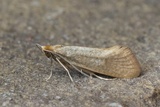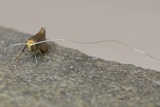Nematopogon swammerdamella (Linnaeus, 1758) Species
Last modified: Feb. 20, 2024, 4:17 p.m.
A common species throughout Belgium.
Details
- Classification
- Family: Adelidae > Subfamily: Nematopogoninae > Genus: Nematopogon > Species: Nematopogon swammerdamella
- Vernacular names
- Bleke langsprietmot (NL), Large Long-horn (EN), l'Adèle de Swammerdam (FR), Große Frühlings-Langhornmotte (DE)
- First mention in Belgium
- De Sélys-Longchamps E. 1844. Énumération des insectes Lépidoptères de la Belgique. — Mémoires de la Société royale des Sciences de Liége 2: 1–35. On page 24 (as Adela swammerdamella L.). view page
- Status
-
Native
Distribution
Imago
The largest species within the genus. Wingspan 18–22 mm. Forewings pale ochreous, light straw-yellow, with more or less strong reticulation. Tornus spot absent. Antennae solid white for the most part of it, not ringed, underside darkly dotted. Head light ochreous-yellow.
Caterpillar
Skin ivory, transparent with internal organs visible; head black; thoracic plates dark brown.
Case
10–14 mm; constructed from four to six crescent-like leaf particles.
Bionomics
Eggs are oviposited in the stems of a variety of lower plants. First instars remain inside the stem and only later drop to the ground where they construct their first case. The more mature larva lives in a bivalved case on the ground, feeding on dead leaves and detritus. It hibernates twice and pupates inside the case before the second hibernation.
The adult moths are active in late afternoon and at dusk.
Flight periods
The adults fly in one generation a year from mid-April till early June.
Observed on
- Substrates:
- Dead leaves and Detritus
Dead leaves of a variety of lower plants and detritus.
Habitat
A great variety of forests in different kind of habitats, from warm and dry deciduous forests to cool pine forests.


